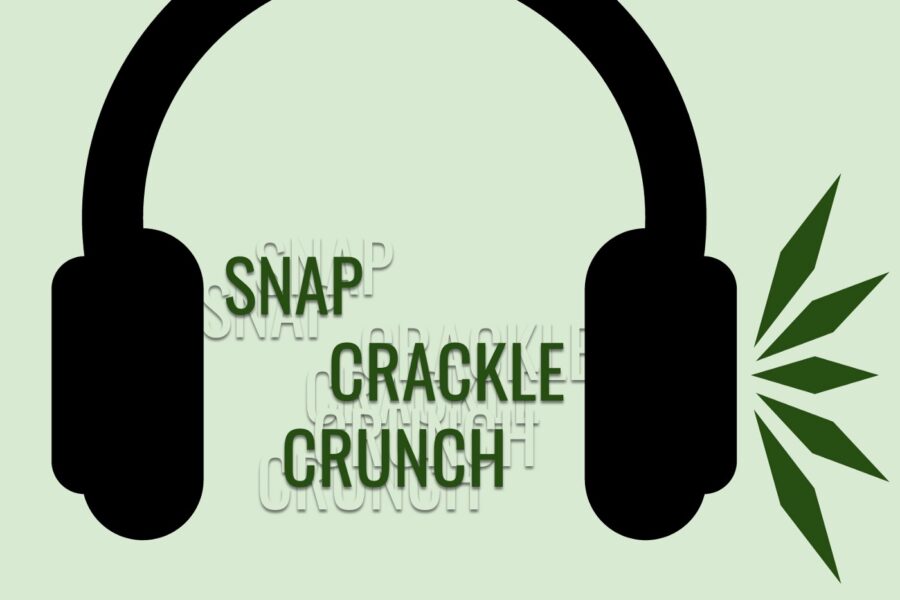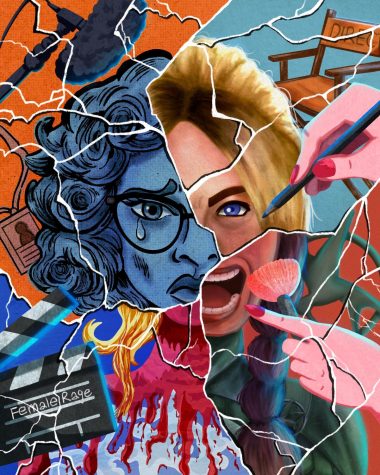Bring on the Brain Tingles
Why you shouldn’t be so quick to bury a friend following the ASMR trend
I sit at my desk and let a pair of noise-cancelling earbuds block out my surroundings as I work. That’s the daily routine for plenty of people and from the way I’m concentrating, a passerby might assume I’ve hopped into Spotify and go on their merry way. As long as I’m discreet and keep my phone screen face-down, though, they’ll never know about what I’m actually listening to. It’s my dusty little secret, my gritty pleasure. Why do I make it sound like I’m hiding something scandalous? It’s because I feel like the moment someone finds out I sometimes work to the sounds of someone crunching up gym chalk, my fate is sealed. They become the judge, jury and executioner for breaking the laws of social norms. The sentence: death by a thousand sounds. Random words are mock-whispered, snacks are chewed louder, and the nearest hard surface gets abused by at least four fingernails for a few seconds of chaos. By the end of it, I’ve likely felt as many tingles as the other guy: a grand total of none. Well, I’m tired of it. I’m tired of the way people are so quick to mock and judge a sensation they simply don’t understand. I’m talking about the internet’s most satisfying topic provoking the most unsatisfying reactions.
So, what exactly is ASMR? Contrary to how its acronym is often used, Autonomous Sensory Meridian Response doesn’t refer to the visuals or audio in those viral “oddly satisfying” videos people watch for hours on Youtube and Instagram; it actually refers to the physical tingling sensation that people experience after encountering such triggers. Also known as “tingles” or “brain tingles,” this sensation often spreads from the scalp to the rest of the body. Feelings of calmness and positivity follow suit, along with the reduction of one’s heartbeat. However, there’s no one trigger guaranteed to induce a reaction, which is why ASMR takes so many forms. For example, while one person might fall asleep to the voice of someone role-playing as a reassuring lover, another might avoid any video that involves talking altogether.
When it comes to the science of ASMR, though, there have been multiple theories produced from the limited amount of research done over the last ten years. One theory is that ASMR might be connected to frisson, which can be summarized as the “chills-down-your-spine” feeling that one might get while listening to certain songs. This is believed to be an involuntary reaction created by a fear response to things such as sudden sharp sounds and a feeling of an intrusion in one’s personal space.
Interestingly enough, Billie Eilish, a popular music artist, utilizes ASMR in her songs. Take for example, her newest album, “When We All Fall Asleep Where Do We Go?” A majority of the songs use a variety of elements also found in ASMR such as “soft whispering,” “rhythmic clicks,” “crisp acoustics” and the use of techniques utilized by foley artists — also known as the people who make sound effects for movies and television. For example, “Bad Guy” includes “amplified finger snaps” instead of snare drums and the chilling drill sound in “Bury a Friend” was actually a recording Eilish took during a dental appointment. In addition to this many ASMR videos tell listeners to use headphones for the best experience and the same goes for Eilish’s music. “The hushed sound of her voice” is purposefully recorded “close-mic’d and whispered.” Her voice is meant to be intimate enough to make it seem like she’s speaking directly into your ear and the stereo or binaural effects found in songs such as “Xanny” and “All the Good Girls Go to Hell” provide a much more immersive, almost 3D effect not easily captured in speakers. Effects such as these could easily induce the reactions most commonly found in people who experience ASMR.
This being said, chances are you might have experienced ASMR without knowing it. Triggers exist everywhere from the crisp flip of a page to the clacking of a keyboard. Multiple studies have shown that, on average, people first experience ASMR between the ages of 5 and 10. So, even in a childhood movie such as “Toy Story 2,” one might find themselves unusually satisfied by the sounds and visuals of Woody getting restored. There’s no shame in it. In 2016, Google published an article stating that there were “5.2 million ASMR videos on Youtube” and that “a top ASMR video can garner 16 million views.” Sciencedaily.com updated this number two years later, stating that there are now “more than 13 million ASMR videos.” Today, the top ASMR video on Youtube has over 80 million views. So what do all these numbers add up to? Well, one doesn’t have to watch a “satisfying math tutoring role-play” video to realize there’s literally millions of people viewing the exact same thing, yet it’s still known as unusual. Don’t get me wrong, there are some weird ones out there, but more often than not, these videos are intended to help people out.
For people who frequently listen to ASMR, there’s a purpose to the pursuit of triggers. An online survey done in 2015 showed that when 475 research participants were asked about why they watch ASMR videos, 98% said it’s to relax, 82% said it’s to help themselves sleep, and 70% said it’s to deal with stress. Another survey done in 2018 showed that out of 284 people, about 60% of the participants used ASMR to either aid sleep or relax two to three times a week or daily. Why is it that people who take medication to help with anxiety and sleep disorders aren’t judged, but people plugging themselves into a pair of headphones are? It doesn’t make any sense to bash on something that is ultimately there to lend an easily-accessible hand in supporting someone’s well-being.
One of the best parts about ASMR is actually the fact that it’s not only about content helping people; it’s also about helping each other. At the time of writing, searching up the hashtag “#asmr” on Instagram results in 7,767,090 posts. Many of these minute-long clips of various triggers include promotions of other ASMR accounts; these posts include reposts, compilations, and original creations inspired by or dedicated to certain ASMR artists or creators. Events such as “#asmrpinkweek” have creators collaborating to make videos in honor of breast cancer awareness. The tag “#asmragainstdomesticviolence” gives accounts the opportunity to share their stories about overcoming abuse and garners hundreds of supporting comments and messages. Accounts often even take requests from viewers and do their best to fulfill them if asked politely. Then whenever someone running an ASMR account is having a hard time in the real world or needs to take a break, their posts are flooded with supportive comments. Any trolls spreading and spamming hate through the comments section and account DMs are promptly shooed away as toxicity and drama has no place here.
The world of ASMR is there to help people take a breath and relax. It’s not meant to be looked at by judgmental eyes or listened to by critical ears. You wouldn’t judge someone for kicking back and binge watching a whole season of “Stranger Things” in a day. So, why take the time to make fun of someone listening to a clip of soap cutting that’s less than a minute long. Why mock the people making three hour long videos to help others sleep?
Honestly, the best way to understand what brings people to do these “weird” things, is to just try it yourself. Since ASMR has been a trend that has risen only recently, with the term only having been coined in 2010, research is limited and it’s believed that not everyone experiences ASMR. Like I said earlier, through, triggers take all kinds of shapes and forms, and I firmly believe that everyone has at least one that resonates with them. For example, if you’re somewhat of a foodie, you might enjoy watching mukbang or a cooking video without talking. If you lean more towards the most common trigger of people whispering or speaking calmly, there are plenty of videos exploring words of love and encouragement; even watching Bob Ross is commonly considered ASMR. It doesn’t matter if your trigger is slime making, sand cutting, floral foam crushing, cornstarch eating, make-up palette tapping, box unwrapping, or even hair combing. In the end, one statement should ring true in your head: “This makes me feel better.” That’s all that should matter.










